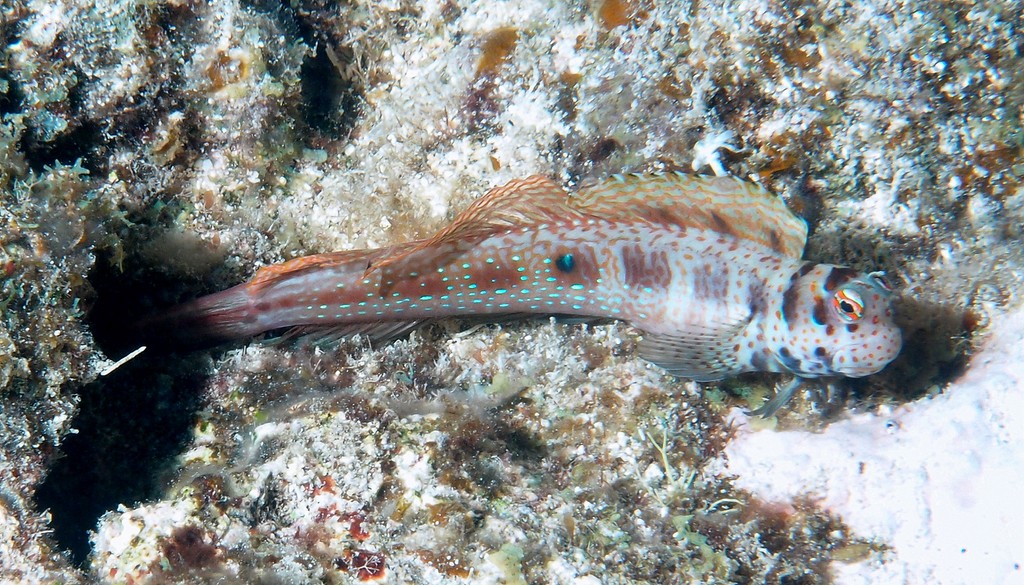BLENNIELLA CHRYSOSPILOS - (BLEEKER, 1857)
Actinopterygii (Gigaclass) > Actinopteri (Class) > Teleostei (Subclass) > Blenniiformes (Order) > Blennioidei (Suborder) > Blenniidae (Family) > Salariinae (Subfamily) > Blenniella (Genus)
Blennie à taches rouges, Cabot sauteur, Goldspotted rockskipper, Orange-spotted blenny, Orange-spotted blenny, Red-spotted blenny, Redspotted rockskipper, Oranje gevlekte blenny, Montsuki-kaeru-uo, モンツキカエルウオ, 冠须动齿鳚, 红点动齿鳚,
Synonymes
Alticus evermanni (Jordan & Seale, 1906)
Istiblennius chrysospilos (Bleeker, 1857)
Istiblennius chrysospilos (insulinus Smith, 1959)
Istiblennius coronatus (Günther, 1872)
Istiblennius insulinus (Smith, 1959)
Salarias aureopuncticeps (Fowler, 1946)
Salarias belemnites (De Vis, 1884)
Salarias bryani (Jordan & Seale, 1906)
Salarias chrysospilos (Bleeker, 1857)
Salarias coronatus (Günther, 1872)
Salarias unimaculatus (Aoyagi, 1954)
-----------------------
Description
Dorsal spines (total): 12; Dorsal soft rays (total): 20-21; Anal spines: 2; Anal soft rays: 21-22. A tan to whitish combtooth blenny with many reddish spots on the head, a series of H-shaped bars along the sides, numerous small pale bluish spots and dashes on the lower sides, and a vertically-elongate dark spot or blotch behind the eye. Females have 8 pairs of narrow reddish to dusky bars on the sides. Meristic, color pattern, and lateral-line pore characters in Blenniella chrysospilos vary considerably geographically. Max. length: 13.0 cm SL. Depth range: 0 - 6 m.
Etymology
Blenniella: from Greek, blenios = mucus. Diminutive of blennius. Referring to scaleless body of blenniids.
chrysospilos: from Greek, chryso = gold + from ancient Greek, spilos = spot. Referring to golden (but usually red) spots on head and body.
Original description: Salarias chrysospilos Bleeker, 1857 - Type locality: Ambon Island, Molucca Islands, Indonesia.
Distribution
Blennie à taches rouges, Cabot sauteur, Goldspotted rockskipper, Orange-spotted blenny, Orange-spotted blenny, Red-spotted blenny, Redspotted rockskipper, Oranje gevlekte blenny, Montsuki-kaeru-uo, モンツキカエルウオ, 冠须动齿鳚, 红点动齿鳚,
Synonymes
Alticus evermanni (Jordan & Seale, 1906)
Istiblennius chrysospilos (Bleeker, 1857)
Istiblennius chrysospilos (insulinus Smith, 1959)
Istiblennius coronatus (Günther, 1872)
Istiblennius insulinus (Smith, 1959)
Salarias aureopuncticeps (Fowler, 1946)
Salarias belemnites (De Vis, 1884)
Salarias bryani (Jordan & Seale, 1906)
Salarias chrysospilos (Bleeker, 1857)
Salarias coronatus (Günther, 1872)
Salarias unimaculatus (Aoyagi, 1954)
-----------------------
Description
Dorsal spines (total): 12; Dorsal soft rays (total): 20-21; Anal spines: 2; Anal soft rays: 21-22. A tan to whitish combtooth blenny with many reddish spots on the head, a series of H-shaped bars along the sides, numerous small pale bluish spots and dashes on the lower sides, and a vertically-elongate dark spot or blotch behind the eye. Females have 8 pairs of narrow reddish to dusky bars on the sides. Meristic, color pattern, and lateral-line pore characters in Blenniella chrysospilos vary considerably geographically. Max. length: 13.0 cm SL. Depth range: 0 - 6 m.
Etymology
Blenniella: from Greek, blenios = mucus. Diminutive of blennius. Referring to scaleless body of blenniids.
chrysospilos: from Greek, chryso = gold + from ancient Greek, spilos = spot. Referring to golden (but usually red) spots on head and body.
Original description: Salarias chrysospilos Bleeker, 1857 - Type locality: Ambon Island, Molucca Islands, Indonesia.
Distribution
Indo-West Pacific: East Africa, Seychelles, Comoros, Madagascar and Mascarenes east to Society Islands, north to southern Japan, south to Queensland (Australia), New Caledonia and Tonga.
Biology
Adults inhabit clear coastal reef flats, often in exposed habitats, common in outer intertidal reef flats and surge-swept seaward reef. Usually where algal growth is prolific. They enter small holes, with just its head protruding. They feed on algae and associated detritus and small invertebrates. Oviparous. Eggs are demersal and adhesive, and are attached to the substrate via a filamentous, adhesive pad or pedestal. Larvae are planktonic, often found in shallow, coastal waters.
Similar species
Blenniella paula (Bryan & Herre, 1903) - Reported from New Caledonia.
Blenniella periophthalmus (Valenciennes, 1836) - Reported from New Caledonia.
Biology
Adults inhabit clear coastal reef flats, often in exposed habitats, common in outer intertidal reef flats and surge-swept seaward reef. Usually where algal growth is prolific. They enter small holes, with just its head protruding. They feed on algae and associated detritus and small invertebrates. Oviparous. Eggs are demersal and adhesive, and are attached to the substrate via a filamentous, adhesive pad or pedestal. Larvae are planktonic, often found in shallow, coastal waters.
Similar species
Blenniella paula (Bryan & Herre, 1903) - Reported from New Caledonia.
Blenniella periophthalmus (Valenciennes, 1836) - Reported from New Caledonia.
Entomacrodus caudofasciatus (Regan, 1909) - Reported from New Caledonia - Link to the species (here).
Entomacrodus striatus (Valenciennes, 1836) - Reported from New Caledonia - Link to the species (here).
